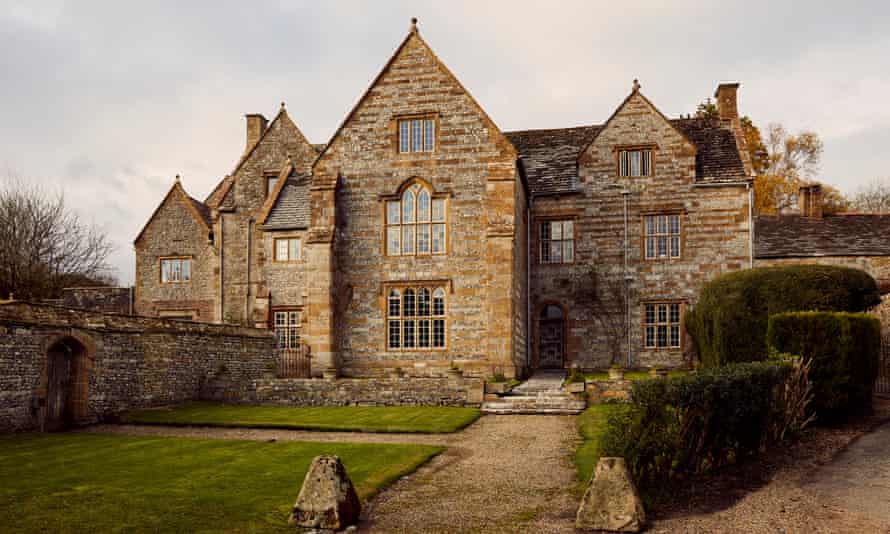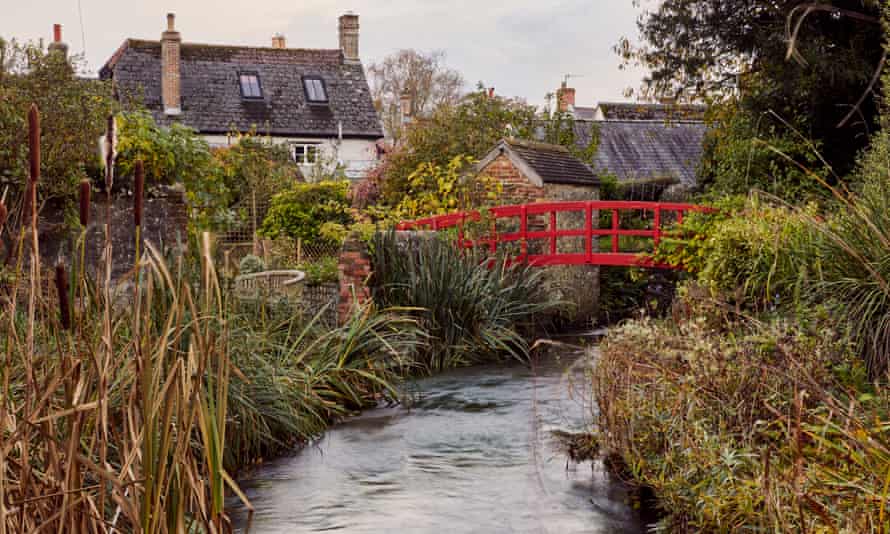Start The New Inn, Cerne Abbas, Dorset
Distance 10 miles
Time 4 hours
Total ascent 380 metres
Difficulty Easy to moderate
Google map of the route
Allow Google content?
This article includes content provided by Google. We ask for your permission before anything is loaded, as they may be using cookies and other technologies. To view this content, click ‘Allow and continue’.
Cerne Abbas lies pretty much in the middle of Dorset, tucked beneath a line of hills that divides the county between the flatter north and the rolling south. Looking at the village’s appealing architectural hotchpotch, you’d be forgiven for thinking that it has always been a happy backwater, but there’s more to it than meets the eye.
Up a little street, beyond an iron gate, I found the only remaining buildings of a large Benedictine abbey: its guesthouse and, in a nearby tranquil garden, the Abbot’s Porch, a three-storey gatehouse with a hidden spyhole for checking on visitors. These grounds are privately owned but open to visitors; the enthusiastic owner told me I was welcome to take photographs – she even offered to take one of me. Next to the adjacent cemetery is Saint Augustine’s Well, a spring named for the saint who almost certainly didn’t visit but who nonetheless was a major draw for medieval pilgrims. Today in this tranquil spot, the surrounding trees are hung with ribbons and messages for the recently departed.
Beyond earthworks that mark the site of more abbey buildings I climbed a steep slope, brushing past the last of the year’s blackberries, to Cerne’s most famous son, the huge chalk figure. It’s not the best view of him (it’s very definitely a him) but I appreciated its huge scale by walking the perimeter of the low fence that encloses it.
In his 1939 guidebook to Dorset, Arthur Mee describes the giant thus: “He equals thirty tall men, standing one on the other, each of his fingers measures 7 feet, and the club in his hand is forty yards long.” But he makes no mention of the size of his most notable feature, a magnificent penis. He’s a controversial figure – as late as the second world war, a letter to a local newspaper suggested he be left to grow over, as he was “a disgrace”.

He is thought to be an ancient figure – possibly Romano-British, maybe a likeness of Hercules – but, strangely there’s no written record of him until 1694. It has been suggested that he was a 17th-century lampoon, a caricature of Oliver Cromwell marauding through the countryside. Dorset was famous for its Clubmen, local vigilantes who despaired of both sides in the civil war, which had brought rape and havoc to rural life. As the name suggests, these would-be rebels were poorly armed,and easily defeated by the New Model army.
Opinion of the giant’s age has been divided, but soil sampling carried out in 2020 revealed something unexpected for both sides of the argument: he is almost certainly Anglo-Saxon. The lead archaeologist, the National Trust’s Martin Papworth, has told me he was astonished by the findings. Yet the giant still keeps secrets – why no one previously took note of him, or why the church permitted a huge figure of a naked man so close to its abbey is unclear. Papworth’s theory is that the giant had been neglected – chalk figures require regular scouring to keep their lines sharp, but centuries later his ghostly shadow became visible in low sunlight, and he was rediscovered.

He’s a shifting figure: the Victorians neglected him too, probably deliberately, fearing for the town’s morals. Later repairs accidentally extended his penis, mistaking the belly button for its end. Mee thought him “very ugly”, but others have been more appreciative. A shop in the village sells an apron bearing his image; you can also buy a small pair of shorts to attach to him for £2.50.
My walk through Cerne Valley was dominated by the giant, who was visible for much of it. I took the spine of the hill above the grand house at Minterne Magna, with occasional, magnificent views across Blackmore Vale to the north. I skirted the long Edwardian house – it isn’t open to the public although the gardens are; the cafe provides a suitable place for lunch, but I ate my squashed cheese sandwich on the hill looking across the valley.

In 2007, the house’s owner, Lord Digby, gave permission for the hillside to be used as a billboard: the giant had a temporary companion: Homer Simpson, aiming a doughnut at his neighbour’s member, to publicise The Simpsons Movie. This outraged pagans, who promised rain magic to wash away Homer’s biodegradable paint. The church of Saint Andrew in Minterne Magna, hard by the road, is tiny and full of huge memorial slabs commemorating the Churchill and Marlborough families; it felt a long way from Springfield.
I followed the course of the river back to Cerne along the hills to the west, an open landscape where late swallows skimmed and tractors clattered, taking in the last of the harvest. I then took a section of the Wessex Ridgeway south, before dipping back along a narrow path in woodland towards Cerne Abbas, past Casterbridge Manor care home, once the town’s workhouse. I stopped briefly at the best viewpoint for the giant, at the top of Duck Street.

Cerne Abbas boasts three pubs, but in the 18th century had as many as 18, serving a much larger population than today – the Abbey had brought it prominence, and brewing brought prosperity, begun by monks and continued by locals. The railway nearly came here in the middle of the 19th century, but nearby Maiden Newton got it instead, and Cerne began a long decline.
In 1906, Frederick Treves, author of Highways and Byways in Dorset, described it as “empty and decaying and strangely silent”. But these days Cerne Abbas is a thriving little community, helped by a steady stream of visitors drawn by the giant, and even brewing has returned – the Cerne Abbas brewery opened in 2016, making beer from locally grown organic barley.
The pub

The 400-year-old New Inn was once a coaching inn and occasional site of the local assizes, and has a wide stone-and-flint frontage. The pub is run by Julian and Annette, who have been here since 2013, is owned by Bridport brewery Palmers, and offers a varied, modern British menu. My smoked tomato and squash ragù was delicious, and the accompanying pint of Copper ale slipped down well. I ate in the restaurant/bar area, but there’s also courtyard seating for warmer days.
The rooms
The New Inn has 10 rooms: some, in converted stables around the courtyard, have a modern feel; others, in the main part of the old pub, have more traditional furniture and decor. In either case you’re unlikely to be much disturbed from a good night’s sleep in Cerne. Refreshed and well fed, next day you’ll be ready to explore more of the county’s charms.
Doubles from £100 abbas .co.uk
Jon Woolcott works for independent publisher Little Toller Books and is writing Real Dorset for Seren Books. Follow him on Instagram at dorsetjonw




